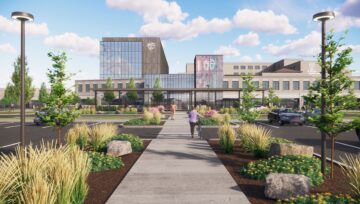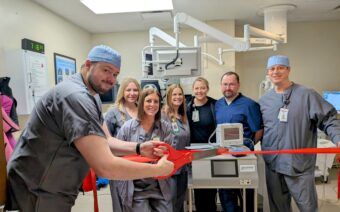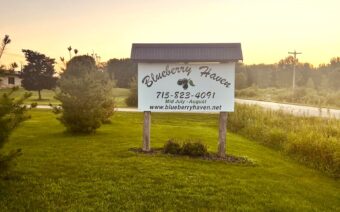
April 21, 2023
GREEN BAY – First opening in 1948, Curative Connections – a Green Bay nonprofit that helps people find support when dealing with aging, dementia, brain injury or disabilities – is celebrating its 75th year of operation in 2023.
And if current president/CEO Jeanne Stangel has her way, Curative will be around for another 75 years.
“I’m one of the younger ones in the group in terms of being at Curative,” she said. “I’ve lived in this community for a long time, and Curative is one of the strongest nonprofit organizations around. It’s strong, sustainable and has survived 75 years of evolving with what the community needs.”
Stangel is Curative’s fourth president and the only female to hold the position.
“In many nonprofits, you seem to find a lot of movement,” she said. “The fact we’ve only had four presidents (in 75 years) speaks volumes to our foundation and the people we have here. I’m proud and honored to serve in this position.”
Stangel said in Curative’s first year, it treated nearly 200 people.
Today, Curative serves 1,825 members each year.
Brenda Jordan, admission coordinator, has been at Curative for 30 years, and said the staff that works for the organization “do it because they love Curative.”
“We believe in our mission and the people we’re helping,” she said. “Curative helps members remain independent and reach their goals – at work, at home or in the community.”
One of those employees is Vice President of Programs Denise Misovec, who has worked for Curative for 14 years.
“We work with adults from the age of 18 until the end of life,” she said. “In our day programs, we support people who want to continue living at home and might need a little extra help during the day – whether that’s to keep them engaged or give caretakers a little break.”
Gary Jordan has served as the nonprofit’s facilities director for the past 42 years and said he likes to showcase the building, which is located at 2900 Curry Lane on Green Bay’s far east side.
“I like to bring people around and show them what we offer,” he said. “One time, I gave a gentleman a tour, and he walked through with me and basically started crying. He told me, ‘My mom was at home sitting in a chair, basically doing nothing.’ He looked at the programs we offer and said again, ‘My mom would have been perfect out here, and I bet her life would have been extended.’ He felt guilty he didn’t know about it.”
Kari Moody, director of donor engagement and marketing, said one of Curative’s goals is “to make sure everyone knows about us.”
“If there comes a time where they need us, nobody goes without – because that’s heartbreaking,” she said.
A look back in time
Misovec said when Curative opened in 1948, it was a rehabilitation facility for people with polio.
“As people were recovering and wanting to get back to life, that’s where services for Curative were born for us,” she said.
As time moved on, Misovec said the services Curative offered also changed.
//tbnapp.cdn.bubble.io/f1682085719852x470131460297787970/richtext_content.webpWhen Curative began in 1948, it served 200 members. Seventy-five years later, it now serves more than 1,800 per year. Photo Courtesy of Curative Connections
“We’ve had to evolve with the times based on what society has dictated and what our members have needed,” she said. “It’s changed – we’ve seen other disabilities. We’ve heard from the community, so we’ve adapted.”
Gary Jordan said Curative has done a good job at changing with the times.
“It’s why Curative has been here so long,” he said. “We don’t get set in our ways and are aware of what’s going on around us in the community – we find the needs. We’ve had programs succeed and others fail – we’ll keep adding.”
Some other changes Curative has seen over the last seven-and-a-half decades, include:
1960s – occupational therapy was added. Services expanded to provide physical restoration to homebound and nursing home residents.1970s – programs continued to expand, and the number of people served continued to grow. Curative purchased 20 acres of land from Brown County, and in 1977, all programs and services moved into a new location at 2900 Curry Lane. Additionally, services for the elderly increased and new programs were added to support the aging population.1980s – Alzheimer’s programming, the senior employment program and a literacy program for people with disabilities were added.1990s – additional programs for aging adults and people with disabilities were put in place, including the Challengers Program for young adults with disabilities. AODA (alcohol and other drug abuse) counseling was added as an outpatient service. Bathing services were added, and the agency continued to grow. The agency also ended a successful capital campaign, raising $2.6 million.In 2018, another capital campaign was completed, and the location at Curry Lane was transformed to accommodate those Curative serves.
Reminiscence care
Moody said the number of people in Brown County experiencing memory loss is growing – rapidly.
“Right now, about 15,000 people in the county are experiencing memory loss,” she said. “That number will double by 2030 and will triple in the 10 years after that. The hospitals are calling it the ‘silver tsunami.’”
To help support the increasing number of memory-loss adults, Moody said Curative is “taking steps to prepare itself.”
“When you talk about Curative pivoting and morphing to what the community needs, we’re in the process of developing Yesteryear Village on the west side of Green Bay,” she said. “Essentially, it’s reminiscence care. It’s being done in the Netherlands now, so we’re modeling it after that. We’ll be the first nonprofit (in the country) to take this on.”
Moody said Yesteryear Village will be located inside Curative’s west side location (1538 Western Ave.), the Cloud Family Care Center, which currently features dementia-specific services.
The 12,000-square-foot renovated space aims to help simulate an environment modeled after the targeted participants’ younger years.
“We’ve learned that for people with memory loss, the memories they retain the best are from ages 18-30,” she said. “You’re going to walk in and feel like you’re in the 1960s.”
The concept emphasizes safety and a sense of purpose through reminiscence and interactive experiences.
Doing so, Moody said, offers a more engaging, relaxing, and familiar space to spend the day.
Gary Jordan said examples of things that will be in the space include: a café, an interactive auto garage, a barbershop, a gas station, a train depot, a pub, downtown shops and more.
“In the center square, we’re also having someone from North Carolina build us a sugar maple tree,” he said. “We’ll have a townhouse off to the right and a Packers-themed tailgate area as well.”
//tbnapp.cdn.bubble.io/f1682085756880x832885570811887200/richtext_content.webpCurative members often take day trips into the community like this one to Bay Beach Amusement Park. Photo Courtesy of Curative Connections
Stangel said Curative has collaborated with Performa Architects and Miron Construction on the project, with work beginning this May and being completed by February 2024.
“We started with a $3.5 million campaign, and now we’re just shy of $5 million,” she said. “That shows the support we have.”
Misovec said Yesteryear Village will be a bit different than some of the reminiscence facilities around the world.
“The people who have done these types of facilities, it’s been residential,” she said. “This is a jump – to go to an adult daycare center using that space and concept. No residents will stay at the facility – it’ll be drop-off and pick-up the same day.”
Stangel said because Wisconsin is a desirable place to live, many people are coming back in their later years – which will lead to an increased need.
“It’s what we call aging immigration,” she said. “More people are coming back because of the low cost of living, good healthcare and a strong education system. Taxes are also decent, and there is a good quality of life. Some people don’t want to deal with earthquakes, wildfires, flooding and tornadoes anymore. Our work will never be done at Curative. It will change and intensify, so what can we do to gear up for that aging population?”
Workers, volunteers needed
Kristine Piontek, vice president of human resources, said there are about 100 staff who run Curative.
“We can always use more,” she said. “With being a nonprofit, maybe the pay isn’t as high as other jobs. We have to compete with many other positions out there. There is a shortage of direct care work employees. It’s not always about the paycheck, but what it pays you back in your heart when you help someone.”
Piontek said Curative also offers flexible work schedules.
“Maybe some other businesses can’t do that,” she said.
Gary Jordan said you could probably make more money working in the private sector, “but it’s not always about money.”
“The people who work here realize that,” he said. “You can have a career but do some good, too.”
Brenda Jordan said Curative is also always looking for volunteer drivers.
“With any nonprofit, volunteers are a big part of what keeps us going,” she said.
In honor of Curative’s 75th year, the nonprofit is hosting two events later this summer to commemorate the milestone.
They include:
A 75th-anniversary celebration – at 4 p.m. July 12 Garden Gala, the annual fundraising event – at 5 p.m. Sept. 12
For more information on Curative, its services or its anniversary events, visit curativeconnections.org.
Curative celebrates solar installation
Curative celebrated Earth Week with a unique “Solar Celebration” – highlighting the organization’s installation of 624 bi-facial monocrystalline solar panels at Curative’s main campus in Green Bay.
Organizers said the array will save the nonprofit nearly $2 million over the panels’ life while reducing its carbon footprint – saving the organization on electrical costs.
The solar panel installation became a reality with the support of Legacy Solar Co-op, Mark and Sue Porath, Eland Electric Corporation, Gauthier & Sons Construction and Schneider Foundation.
Curative also received grant funds from Renew Wisconsin/Solar for Good, Public Service Commission of Wisconsin/Office of Energy Innovation and Focus on Energy.
 GRB’s United Airlines team honored with safety award
GRB’s United Airlines team honored with safety award HSHS to invest $270 million in St. Mary’s, St. Vincent
HSHS to invest $270 million in St. Mary’s, St. Vincent








